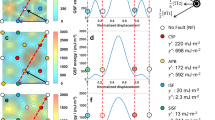Abstract
The classical theory of the crystallography of martensitic transformations developed in the 1950s is based on the notion that the interface between the parent and product phases is an invariant plane of the shape deformation. Underlying this hypothesis is the expectation that such interfaces do not exhibit long-range strain, and the geometric theory is an algorithm for finding invariant planes, the orientation relationship and transformation displacement. In the context of ferrous alloys, the classical theory has been applied successfully to transformations with {295} habit planes, but is less satisfactory for {575} for example. A new model of martensitic transformations has been presented recently based on dislocation theory, incorporating developments in the understanding of the topological properties of interfacial defects. Topological arguments show that glissile motion of transformation dislocations, or disconnections, can only occur in coherent interphase interfaces. Hence, the interface in the model comprises coherent terraces with a superimposed network of disconnections and crystal dislocations. It is demonstrated explicitly that this defect network accommodates the coherency strains, and that lateral motion of the disconnections across the interface effects transformation in a diffusionless manner. Moreover, it is shown that a broader range of habit planes is predicted on the basis of the semi-coherent interface model than the invariant plane notion. In the case of ferrous alloys, it will be shown that a range of viable solutions arise which include {575}.










Similar content being viewed by others
References
Christian JW (2002) The theory of transformations in metals and alloys. Pergamon Press, Oxford
Olson GB, Owen WS (eds) (1992) Martensite. ASM International, USA
Wechsler MS, Lieberman DS, Read TA (1953) Trans AIME 197:1503
Bowles JS, MacKenzie JK (1954) Acta Metall 2:129, 138, 224
McDougall PG, Wayman CM (1992) In: Olson GB, Owen WS (eds) Martensite. ASM International, USA, p 59
Pond RC, Celotto S, Hirth JP (2003) Acta Mater 51:5385
Pond RC, Hirth JP, Ma X, Chai YW (2007) Topological modelling of martensitic transformations. In: Nabarro FRN, Hirth JP (eds) Dislocations in solids, vol. 13. Elsevier, Amsterdam, p 227
Hirth JP (1994) J Phys Chem Sol 55:985
Sutton AP, Balluffi RW (1995) Interfaces in crystalline materials. Clarendon Press, Oxford
Hall MG, Aaronson HI, Kinsman KR (1972) Surf Sci 31:257
Roitburd AL (1976) Solid State Phys 33:317
Dahmen U (1987) Scripta Metall 21:1029
Smith DA (1987) Scripta Metall 21:1009
Pond RC, Ma X (2005) Z fur Metal 96:1124
Crocker AG (1962) Philos Mag 7:1901
Pond RC (1989) Line defects in interfaces. In: Nabarro FRN (ed) Dislocations in solids, vol. 8. North-Holland, Amsterdam, p 1
Christian JW (1994) Metall Mater Trans 25A:1821
Bilby BA, Bullough R, Smith E (1955) Proc Roy Soc 231A:263
Ma X, Pond RC (2007) J Nucl Mater 361:313
Wayman CM (1964) Introduction to the crystallography of martensite transformations. Macmillan, New York
Hammond C, Kelly PM (1969) Acta Metall 17:869
Hirth JP, Lothe J (1982) Theory of dislocations. McGraw-Hill, New York
Hirth JP, Pond RC, Lothe J (2006) Acta Mater 54:4237–4245
Matthews JW (1974) Phil Mag 29:797
Kurdjumov GV, Sachs G (1930) Z Phys 64:325
Sandvik BPJ, Wayman CM (1983) Metall Trans 14A:835
Kelly PM, Jostsons A, Blake RG (1990) Acta Metal Mater 38:1075
Pond RC, Celotto S (2003) Int Mater Rev 48:225
Misra A, Hirth JP, Hoagland RG, Embury JD, Kung H (2004) Acta Mater 52:2387
Author information
Authors and Affiliations
Corresponding author
Rights and permissions
About this article
Cite this article
Pond, R.C., Ma, X. & Hirth, J.P. Geometrical and physical models of martensitic transformations in ferrous alloys. J Mater Sci 43, 3881–3888 (2008). https://doi.org/10.1007/s10853-007-2158-9
Received:
Accepted:
Published:
Issue Date:
DOI: https://doi.org/10.1007/s10853-007-2158-9




